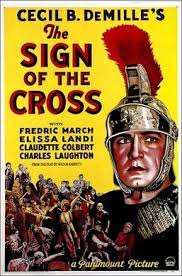
Emperor Nero (Charles Laughton) is gleefully sitting on his throne and playing his lyre while watching Rome burn. Tigellinus (Ian Keith) warns Nero that unless he finds a scapegoat the people will blame him for the fire. He suggests that Nero blame the fire on the Christians. Nero thinks this is a wonderful idea and begins gathering up all the Christians and killing them.
In the town square, Titus (Arthur Hohl) arrives from Jerusalem. He is a Christian sent by Paul to preach to the Christians of Rome. He meets Favius (Harry Beresford). The two men are captured by Nero’s guards. Mercia (Elissa Landi), one of Favius’ wards, tries to come to their aid and is captured as well. Along comes Marcus Superbus (Fredric March) who immediately falls in love with Mercia and has them freed.
The Empress of Rome, Poppaea (Caludette Colbert), who is in love with Marcus, finds out that Marcus is in love with Mercia. Tigellinus is jealous of Marcus’ relationship with Nero. Favius’ other ward, Stephen (Tommy Conlon) is captured by the Roman guards and tortured to reveal the location of the Christians’ next meeting. The guards attack the Christians and capture those they do not kill. Marcus intercedes and has the Christians sent to prison instead of the arena. Mercia is sent to Marcus’ home. Marcus tries to get Mercia to renounce her Christian faith, but Mercia would rather go to the arena and be fed to the lions than abandon her beliefs.
“The Sign of the Cross” was released in 1932 and was directed by Cecil B. DeMille. It is a pre-code American religious epic and a sword and sandal film. The film is based on the 1895 play by Wilson Barrett.
There are a lot of things here that prove the movie is pre-code. Examples would be, Claudette Colbert bathing in a vat of ass milk, a lesbian dance done by Joyzelle Joyner, naked women dressed in flowers being presented to crocodiles, lions and a gorilla, people being eaten, gored and stomped on by, tigers, bulls and elephants and various other atrocities that were inflicted on Christians. The film also has undertones of homosexuality.
The film was re-released in 1944 in the U.S. By then the Hays Act was being enforced. Several scenes were cut, including the lesbian dance, the naked women being attacked by crocodiles and the gorilla as well as some of the gladiatorial scenes. Some additional footage was shot and added to the film to increase the length of the movie. The additional footage was modern and had nothing to do with the film. For a while the updated version was the only one available. When the film was restored in 1993 the original footage was restored. Some of the scenes cut out ended up having a life of their own to the point that when they were restored to the film, they weren’t as explicit or as horrifying as what people imagined they were. At least not to the modern eye.
The scene where Claudette Colbert, who plays Poppaea, is bathing in milk took several days to film. DeMille told everyone that it was real donkey milk that was used. In reality it was powdered cow’s milk. Even so, under the hot lights and over several days the milk turned sour and ended up the consistency of cottage cheese. It also had a nasty smell by the time shooting was completed.
This is the third film in what is considered Cecil B. DeMille's biblical trilogy. The other two films are “The Ten Commandments” 1923 and “The King of Kings” 1927.
Movie
1944 Trailer

